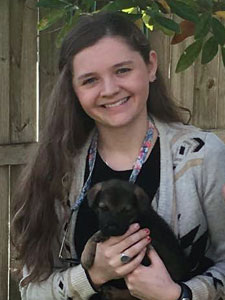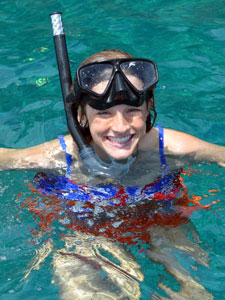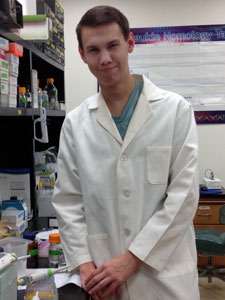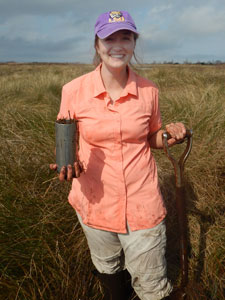Undergraduate Research Opportunities Program
About UROP | FAQs | Funded Projects | Application | Contact
Funded Projects: 2016
 Ryan Brown, biology major, Department of Biological Sciences, Nicholls State University (NSU) Faculty advisor: Raj Boopathy, Department of Biological Sciences Does Salinity Have an Impact on Antibiotic Resistant Bacteria and Antibiotic Resistance Genes in the Bayous of Southeast Louisiana?
Ryan Brown, biology major, Department of Biological Sciences, Nicholls State University (NSU) Faculty advisor: Raj Boopathy, Department of Biological Sciences Does Salinity Have an Impact on Antibiotic Resistant Bacteria and Antibiotic Resistance Genes in the Bayous of Southeast Louisiana?
There is an increasing amount of antibiotic resistance in various bacterial species. This project will test for antibiotic-resistant bacteria and antibiotic-resistant genes at three sites with various salinity levels on Bayou Petite Caillou in southeast Louisiana. The research group also will analyze the differences in antibiotic resistance and fecal coliform bacteria levels among different salinities in the bayou.
 Coleen Cecola, biology major, Department of Biological Sciences, Louisiana State University (LSU) Faculty advisor: Morgan Kelly, Department of Biological Sciences Testing for Local Adaptation among Populations of Eastern Oysters (Crassostrea virginica) Inhabiting a Natural Salinity Gradient in the Gulf of Mexico
Coleen Cecola, biology major, Department of Biological Sciences, Louisiana State University (LSU) Faculty advisor: Morgan Kelly, Department of Biological Sciences Testing for Local Adaptation among Populations of Eastern Oysters (Crassostrea virginica) Inhabiting a Natural Salinity Gradient in the Gulf of Mexico
C. virginica is an ecologically and economically important species whose current distribution in the Gulf of Mexico is determined primarily by salinity, an environmental variable that is expected to change over the coming century. The project will test whether oyster stocks differ in their salinity tolerances, with the goal of providing support to coastal restoration efforts by identifying adaptive variation among stocks that could be targeted for selective breeding.
 Viet Dao, environmental sciences major, School of the Coast and Environment, LSU Faculty advisor: Crystal Johnson, Department of Environmental Sciences Fire and Bacterial Biodiversity in Marsh Soils
Viet Dao, environmental sciences major, School of the Coast and Environment, LSU Faculty advisor: Crystal Johnson, Department of Environmental Sciences Fire and Bacterial Biodiversity in Marsh Soils
Wildfires, as natural ecological processes, are important for maintaining terrestrial and wetland ecosystems. However, the effects of fires on soil microbes and their roles in nutrient cycling are poorly studied. The project’s aim is to quantify the extent of bacterial biodiversity before and after fires and compare this biodiversity to the biodiversity in non-burned areas.
 Cary Michelle Darbonne, environmental science major, Department of Earth and Environmental Sciences, University of New Orleans Faculty advisor: Malay Ghose-Hajra, Department of Civil and Environmental Engineering Use of Unmanned Aircraft Systems (UASs) to Monitor Coastal Hazard, Design Mitigation Measures and Evaluate Long-term Health of Louisiana’s Coastline
Cary Michelle Darbonne, environmental science major, Department of Earth and Environmental Sciences, University of New Orleans Faculty advisor: Malay Ghose-Hajra, Department of Civil and Environmental Engineering Use of Unmanned Aircraft Systems (UASs) to Monitor Coastal Hazard, Design Mitigation Measures and Evaluate Long-term Health of Louisiana’s Coastline
The objectives for this project include: usage of an unmanned aircraft system (UAS) to conduct a geospatial aerial survey of coastal Louisiana to evaluate and monitor coastal land loss; use a UAS to monitor performance of coastal protection features like levees, floodwalls and pumping stations; and use the aerial survey data and georeferenced imagery to develop a GIS-based database of coastal features that can be used by researchers, engineers and scientists during the planning, design and construction of coastal restoration and protection projects.
 Amanda Fontenot, coastal environmental science major, School of the Coast and Environment, LSU Faculty advisor: John R. White, Department of Oceanography and Coastal Sciences Fate of Wetland Soil Carbon in Coastal Louisiana’s Eroding Coastal Wetlands in Barataria Bay
Amanda Fontenot, coastal environmental science major, School of the Coast and Environment, LSU Faculty advisor: John R. White, Department of Oceanography and Coastal Sciences Fate of Wetland Soil Carbon in Coastal Louisiana’s Eroding Coastal Wetlands in Barataria Bay
Wetland soil cores will be collected from eroding coastal marshes. Project objectives are to determine organic matter decomposition rates by soil depth intervals and then to calculate the annual carbon dioxide (CO2) release into the atmosphere based on coastal land loss maps. Once that is completed, dissolved organic carbon (DOC) release rates from eroding marshes can be determined.
 Brendan Copley, coastal engineering major, Department of Civil and Environmental Engineering, LSU Faculty advisors: Navid Jafari and Qin Chen, Department of Civil and Environmental Engineering Effect of Soil Strength and Vegetation on Marsh Edge Erosion for Louisiana Coastal Protection and Restoration
Brendan Copley, coastal engineering major, Department of Civil and Environmental Engineering, LSU Faculty advisors: Navid Jafari and Qin Chen, Department of Civil and Environmental Engineering Effect of Soil Strength and Vegetation on Marsh Edge Erosion for Louisiana Coastal Protection and Restoration
The project’s primary objectives are to identify the soil and vegetation properties that influence marsh edge resistance to erosion; and produce a field-validated marsh edge erosion model for the Terrebonne Bay and Brenton Sound area that incorporates coastal, geotechnical and ecological engineering parameters.
 Ryan Hoffman, biological sciences major, College of Science, LSU Faculty advisor: Fernando Galvez, Department of Biological Sciences Physiological Resilience of Coastal Marine Fish to Hypoxia
Ryan Hoffman, biological sciences major, College of Science, LSU Faculty advisor: Fernando Galvez, Department of Biological Sciences Physiological Resilience of Coastal Marine Fish to Hypoxia
Plans to divert fresh water and sediment from the Mississippi River into coastal marsh regions of Louisiana in order to mitigate land loss are likely to increase the frequency of hypoxia (oxygen deficiency) in those areas. The project will assess the level of hypoxia tolerance in several species of Fundulidae (topminnows and killifish) living in southern Louisiana. Understanding the physiological resilience of resident fish species to variations in estuarine oxygen levels may predict the effect of diversions on the aquatic ecosystems.
 Sara King, renewable natural resources major, School of Renewable Natural Resources, LSU Faculty advisor: Wei Xu, Department of Renewable Natural Resources Selection of Dermo Disease-Resistant Eastern Oyster (Crassostrea virginica) Strains with Immune Related Markers
Sara King, renewable natural resources major, School of Renewable Natural Resources, LSU Faculty advisor: Wei Xu, Department of Renewable Natural Resources Selection of Dermo Disease-Resistant Eastern Oyster (Crassostrea virginica) Strains with Immune Related Markers
Perkinsus marinus, a dermo disease, is responsible for nearly half of the eastern oyster mortalities in the Gulf of Mexico annually. The project’s objective is to identify wild, dermo-resistant eastern oyster strains that potentially can be used as brood stocks for selective breeding programs.
 Shannon Matzke, coastal environmental science major, School of the Coast and Environment, LSU Faculty advisor: Tracy Quirk, Department of Oceanography and Coastal Sciences Influence of Nutrient Availability, Sediment Supply and Elevation on Productivity of Spartina patens
Shannon Matzke, coastal environmental science major, School of the Coast and Environment, LSU Faculty advisor: Tracy Quirk, Department of Oceanography and Coastal Sciences Influence of Nutrient Availability, Sediment Supply and Elevation on Productivity of Spartina patens
The goal of the project is to examine the interaction between nutrient availability, sedimentation and elevation on the productivity of the marsh plant Spartina patens in a controlled greenhouse environment. This research is directly applicable to management considerations involving river sediment diversions and thin-layer dredge sediment application for restoration of coastal wetlands under high nutrient and increasing water level conditions.
 Sarah Soorya, pre-medicine major, Department of Biological Sciences, NSU Faculty advisor: Rajkumar Nathaniel, Department of Biological Sciences Purification and Characterization of Bacteriophage Protein(s) Isolated from V. parahaemolyticus in Oysters
Sarah Soorya, pre-medicine major, Department of Biological Sciences, NSU Faculty advisor: Rajkumar Nathaniel, Department of Biological Sciences Purification and Characterization of Bacteriophage Protein(s) Isolated from V. parahaemolyticus in Oysters
Vibrio parahaemolyticus is a bacterium that is the leading cause of seafood-associated bacterial gastroenteritis. A previous Louisiana Sea Grant project led to the discovery of a potential novel phage specific to this bacterium. The current project will purify and separate the phage as well as phage-associated proteins so they can be used in the future as immunogens to produce antibodies. Potentially, the virus could be used in aquaculture disease management.
 Connor Tiersch, petroleum engineering major, Petroleum Engineering, LSU Faculty advisor: Todd Monroe, Department of Biological and Agricultural Engineering 3-D Printing of Practical Vitrification Devices for Germplasm Repository Development in Aquatic Species
Connor Tiersch, petroleum engineering major, Petroleum Engineering, LSU Faculty advisor: Todd Monroe, Department of Biological and Agricultural Engineering 3-D Printing of Practical Vitrification Devices for Germplasm Repository Development in Aquatic Species
Vitrification – encapsulating a substance in a glass or tube made of another material – is one of the most efficient methods of cryopreservation. The goal of this project is to design, prototype and use 3-D printing methods to fabricate standardized receptacles that can be used for the vitrification of aquatic species’ sperm.
 Kelsey Van Dam, biological sciences major, Department of Biological Sciences, Loyola University Faculty advisor: Frank Jordan, Department of Biological Sciences and Environment Assessment of Recruitment of Blue Crab Larvae into Lake Pontchartrain Estuary
Kelsey Van Dam, biological sciences major, Department of Biological Sciences, Loyola University Faculty advisor: Frank Jordan, Department of Biological Sciences and Environment Assessment of Recruitment of Blue Crab Larvae into Lake Pontchartrain Estuary
The project objective is to quantitatively sample and compare the abundance of blue crab larvae interior and exterior to the Inner Harbor Navigation Canal Surge Barrier (IHNCSB). Data collected will be used to test the hypothesis that construction of the IHNCSB has not adversely affected recruitment of blue crab larvae. Results may be used to inform the design and construction of future projects intended to minimize the effects of storm surges in coastal Louisiana.
